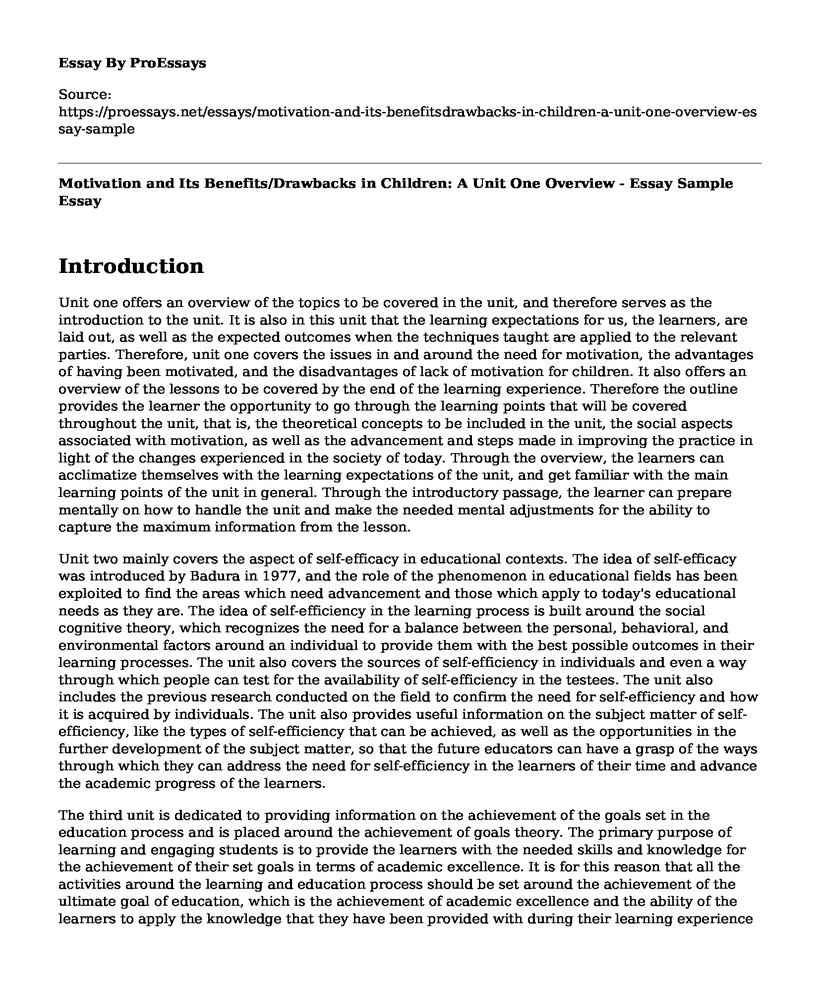Introduction
Unit one offers an overview of the topics to be covered in the unit, and therefore serves as the introduction to the unit. It is also in this unit that the learning expectations for us, the learners, are laid out, as well as the expected outcomes when the techniques taught are applied to the relevant parties. Therefore, unit one covers the issues in and around the need for motivation, the advantages of having been motivated, and the disadvantages of lack of motivation for children. It also offers an overview of the lessons to be covered by the end of the learning experience. Therefore the outline provides the learner the opportunity to go through the learning points that will be covered throughout the unit, that is, the theoretical concepts to be included in the unit, the social aspects associated with motivation, as well as the advancement and steps made in improving the practice in light of the changes experienced in the society of today. Through the overview, the learners can acclimatize themselves with the learning expectations of the unit, and get familiar with the main learning points of the unit in general. Through the introductory passage, the learner can prepare mentally on how to handle the unit and make the needed mental adjustments for the ability to capture the maximum information from the lesson.
Unit two mainly covers the aspect of self-efficacy in educational contexts. The idea of self-efficacy was introduced by Badura in 1977, and the role of the phenomenon in educational fields has been exploited to find the areas which need advancement and those which apply to today's educational needs as they are. The idea of self-efficiency in the learning process is built around the social cognitive theory, which recognizes the need for a balance between the personal, behavioral, and environmental factors around an individual to provide them with the best possible outcomes in their learning processes. The unit also covers the sources of self-efficiency in individuals and even a way through which people can test for the availability of self-efficiency in the testees. The unit also includes the previous research conducted on the field to confirm the need for self-efficiency and how it is acquired by individuals. The unit also provides useful information on the subject matter of self-efficiency, like the types of self-efficiency that can be achieved, as well as the opportunities in the further development of the subject matter, so that the future educators can have a grasp of the ways through which they can address the need for self-efficiency in the learners of their time and advance the academic progress of the learners.
The third unit is dedicated to providing information on the achievement of the goals set in the education process and is placed around the achievement of goals theory. The primary purpose of learning and engaging students is to provide the learners with the needed skills and knowledge for the achievement of their set goals in terms of academic excellence. It is for this reason that all the activities around the learning and education process should be set around the achievement of the ultimate goal of education, which is the achievement of academic excellence and the ability of the learners to apply the knowledge that they have been provided with during their learning experience in their real-life experiences. Despite there being a central goal of education, that is, the achievement of academic excellence, there are other aspects of education that need to be addressed, and therefore the educator needs to learn how to set other multiple goals to be achieved in the course of the learning process. Some of the goals that can be covered in the process include equipping the learner with the social skills needed that will help them learn better, as well as aiding them in coping with the future needs of their lives and those of the people that they will interact with.
Finally, the fourth unit addresses the issues that may hinder the process of learning and motivation of students. This unit mainly covers problems that may make the process of motivation and self-efficiency in the learning process, and how the lack of the same will lead to deterrence and retardation of the learning process. The method of removing the barriers to effective communication is a collaborative one that needs the educators and the parents or guardians to create positive learning environments that will help the learners in adapting to the needs of their learning environments. More importantly, the learners need to be equipped with the required cognitive skills and coping mechanisms that will help them in staying objective to the achievement of educational excellence despite the issues that may occur in or around them and therefore helping them to achieve the primary goal of education- to get the highest levels of qualifications and accolades while also providing them with the necessary tools needed for the dealing with the issues that they may experience in their lives, in the present, and future. Therefore, the education process would be deemed inefficient and insufficient in achieving its goals should it not cover the issues concerning the motivation of students to achieve their set goals.
Cite this page
Motivation and Its Benefits/Drawbacks in Children: A Unit One Overview - Essay Sample. (2023, Aug 28). Retrieved from https://proessays.net/essays/motivation-and-its-benefitsdrawbacks-in-children-a-unit-one-overview-essay-sample
If you are the original author of this essay and no longer wish to have it published on the ProEssays website, please click below to request its removal:
- Paper Sample on Culture and Work
- Essay Sample on Communication Issue in a Workplace
- Career and Reasons Why Ethics and Integrity is Vital in my Future Practice
- Supply Chain and Operational Management Application Letter
- Nursing Philosophy Paper Example
- Essay Example on Conflict Resolution in Schools: Challenges for Teachers
- Essay on Motivation Beyond Money: The Puzzle of Intrinsic Workplace Performance







